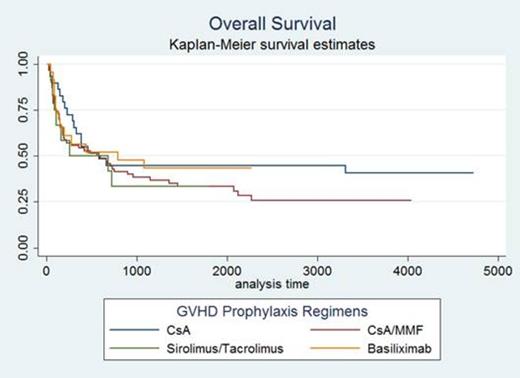Abstract
Graft-versus-host disease (GVHD) remains the 2nd leading cause of mortality—after relapse/progression following allogeneic hematopoietic cell transplantation for the treatment of hematological malignancies. The incidence of clinically significant GVHD ranges from 10 to 80% and accounts for approximately 10-20% transplant related mortality. The combination calcineurin inhibitor and methotrexate is widely used as a GVHD preventive following myeloablative conditioning; however, there is no standard prophylaxis regimen for Cy/Flu minimal intensity nonablative transplants. The objective of the current study is to compare outcomes in patients treated at a single institution with identical conditioning regimens and supportive methods but different GVHD preventive regimens.
Outcomes on 134 patients who underwent nonmyeloablative transplant between May 2000 and Nov 2011 were retrospectively analyzed. The primary endpoint was incidence and severity of acute GVHD (aGVHD). Secondary endpoints included incidence and severity of chronic GVHD (cGVHD), incidence of relapse, overall survival (OS), progression-free survival (PFS) and causes of death.
Median follow-up was 49 months; the median age at transplant was 56 years, 66% of patient were not in remission at time of transplant (predominately myelodysplasia). Donors were peripheral blood mononuclear cell (PBMC, n=133) or bone marrow (n=1) HLA matched related or partially matched (9/10) donors. GVHD preventive regimens included the following: (1) single agent cyclosporine (CsA); (2) combination CsA/mycophenolate mofetil (MMF); (3) CsA+ basiliximab after ANC > 500/mm3; (4) CsA + basiliximab post-transplant, pre-engraftment; (5) sirolimus + tacrolimus.
The incidence of grade III-IV acute GVHD was lower in patients who received sirolimus/tacrolimus than patients in the cyclosporine group (25% and 32%, respectively; p = .062). There was a significantly higher proportion of patients in the cyclosporine group who had clinical extensive chronic GVHD (62% vs. 25%, p = .008). The incidence of relapse trended higher in the sirolimus/tacrolimus group compared to CsA alone or CsA/MMF (50% vs. 28% vs. 30%, respectively, p= .519). There was a trend towards slightly better OS and PFS with the cyclosporine-based prophylaxis, but follow-up was longer with these regimens.
Sirolimus/tacrolimus provides potent GVHD prophylaxis for nonmyeloablative Cy/Flu allogeneic transplantation; however, may be associated with higher relapse/progression rates. Larger numbers and/or comprehensive analyses of multicenter registry data might help further delineate differences in clinical outcomes between these regimens.
No relevant conflicts of interest to declare.
Author notes
Asterisk with author names denotes non-ASH members.



This feature is available to Subscribers Only
Sign In or Create an Account Close Modal